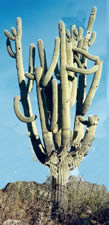
Dimdima
Online Children's Magazine from India

Dimdima
Online Children's Magazine from India

What if you had to begin your life as a small tiny speck and then grow only a few inches every few years? Imagine waiting for almost 200 years to grow to your full height. Imagine spending your whole life in a hot, dusty desert with rattlesnakes and coyotes and wild bats for company. It might seem like a tough way to live, but the saguaro cactus seems to thrive under these conditions.
The saguaro (suh-wah-ro) is the state flower of Arizona. It cannot survive anywhere in the world except in the Sonoran desert spanning southeastern California, southern Arizona and northwestern Mexico. In botanical terms, the saguaro is known as Carnegiea Gigantea. A typical saguaro cactus is a tall flute-like column with several arms. Older specimens are often 30 feet tall. On dark desert nights, the arms of this tree give it an almost humanlike appearance. An amazing fact about the saguaro is that it begins to grow arms only when it is about 60 years old. Older cacti have many arms. In late spring, these arms get tipped by beautiful white flowers that bloom at night.
The birth of a new cactus is a complicated process. Bats and other desert critters love to drink the nectar from saguaro flowers. Pollen from the flowers sticks to the feet and wings of these creatures. When they move on to other trees, they carry the pollen with them. This helps in pollination. Fruits grow as a result of pollination. These fruits contain seeds. When the ripe fruit falls to the ground, the seeds get dispersed. Under perfect conditions, the seeds germinate and a new tree is born.
The saguaro is very well adapted to the harsh environs of its homeland. Despite its huge size, the roots of the saguaro cactus do not go very deep into the desert soil. This makes the tree vulnerable to winds, lightning and other natural elements. That is why a young saguaro usually grows in the shadow of a “nurse” – a tree or shrub that will provide some shadow and safety from the strong desert winds, and the harsh sunlight. During the meager monsoon season, the roots of the saguaro soak up water. This moisture is stored in the stem and the roots of the plant. Thorny spines grow all over the body of this cactus. These spines help trap moisture and also keep preying animals away. A waxy coating covers the entire plant body. This also helps in water retention.
Today, the saguaro is the most popular symbol of the Sonoran desert. Photographers love shooting pictures of this brave survivor. Tourists love posing for pictures beside these tall desert warriors. Desert dwellers love making jams and jellies from the fruit of the saguaro tree. Unfortunately, however, humans are endangering this species. Some people uproot saguaro cacti from the wild and carry them away in order to replant them in their own gardens. Suburban sprawl is another factor that is threatening the survival of this species. As homes and communities move closer and closer into the desert regions, natural wildlife gets wiped out.
The government of Arizona has recognized this and has set up laws that prohibit the illegal digging up of saguaros. Wildlife parks and preserves have also been set up to protect some of the wildlife and to prohibit encroachment by humans. As a tribute to its state flower, all vehicle license plates in the state of Arizona have the sign of the mighty saguaro. Arizonians love this tree and take pride in preserving these historic specimens for the enjoyment of the coming generations.
Dimdima is the Sanskrit word for ‘drumbeat’. In olden days, victory in battle was heralded by the beat of drums or any important news to be conveyed to the people used to be accompanied with drumbeats.
Bharatiya Vidya Bhavan
K. M Munshi Marg,
Chowpatty, Mumbai - 400 007
email : editor@dimdima.com
Bharatiya Vidya Bhavan
505, Sane Guruji Marg,
Tardeo, Mumbai - 400 034
email : promo@dimdima.com
Dimdima.com, the Children's Website of Bharatiya Vidya Bhavan launched in 2000 and came out with a Printed version of Dimdima Magazine in 2004. At present the Printed Version have more than 35,000 subscribers from India and Abroad.